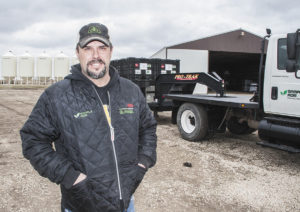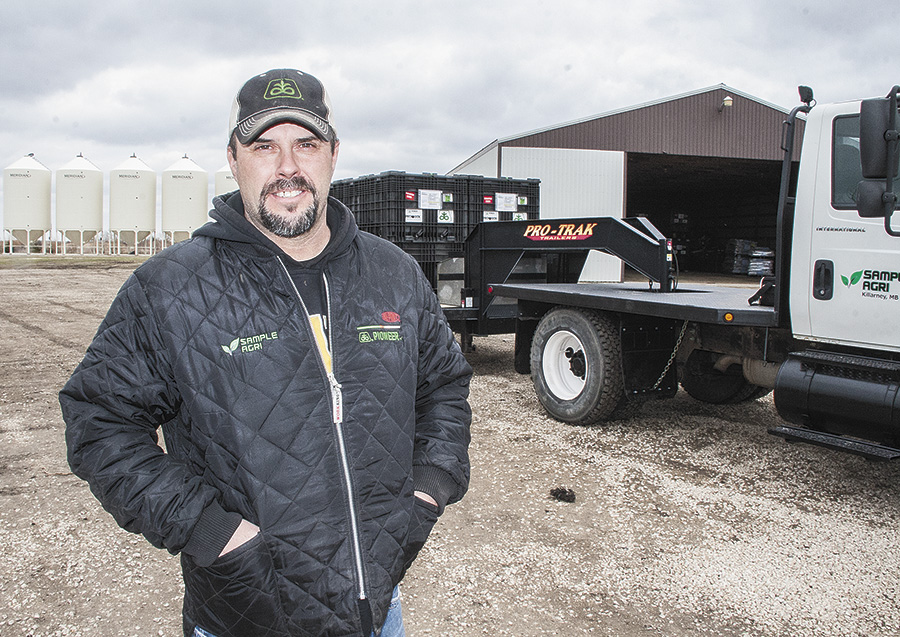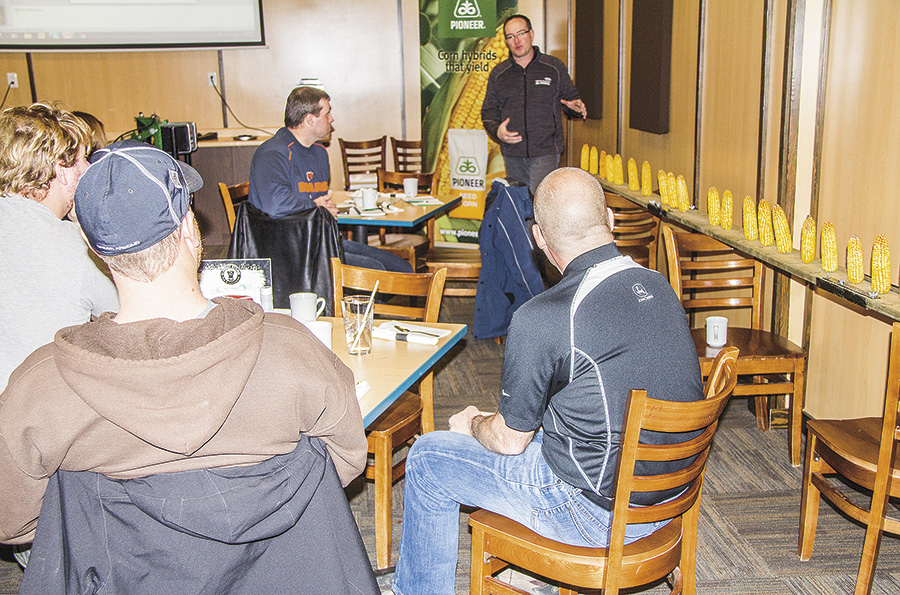
BY KIM LANGEN
Could a golden crop of field corn be a good fit for the area?
Local seed rep Steve Sample thinks so.
In fact, he’s so keen that he hosted a Learn to Grow Corn meeting back in December, with a line-up of Manitoba’s top corn experts getting up to give local producers their best advice on growing the crop.
A major blizzard foiled Sample’s first attempt to spread the news on Zea mays (Latin for maize, or corn, which is a kind of grass), but the local grain corn zealot rescheduled for Monday, December 12, at the Blarney Stone Restaurant, to spread the news on new varieties and new opportunities.
Now that spring is here, he’s hoping to see more fields of the tall green crop sprout up in the area.
And he can barely keep up with demand for seed.
“Corn in southwestern Manitoba is definitely on the rise,” said Sample this week, a sales rep for DuPont Pioneer and operating as Sample Agri. “In fact, DuPont Pioneer is almost sold out of corn. I can still get it, but corn is very thin.
“I’ve got over 100 ProBoxes of corn seed here, and each one holds 2,500 pounds of seed. There’s another 30 coming, and when they arrive, we start delivering in the Killarney area. Sales here have tripled; corn is exploding. In this corner of the province, there’s 64,000 acres of corn being planted in 2017.”
Area farmers appear keen to try out the crop, while others keep an eye on its progress, he added.
“We are getting a lot of people talking about corn, and a lot of guys are going to be watching how it goes,” said Sample. “I talked to our territory manager, and he said corn sales are up 140 per cent in his southwest territory.
So why the rush on corn?
“Corn gives us another rotation crop, and the net margin is very good,” said Sample, who took up his position as a sales rep with the company just last August. “It’s way better than wheat. Plus the varieties are getting better all the time. We have 72 to 75 day corn – that’s a safe option – and you can also get a 79 day corn.”
And with a unanimous approval by the municipal council this week to go ahead with an application to build a new HyLife feed mill, with construction beginning this year in Killarney, demand is set to rise, said Sample.
“With the new HyLife feed mill, and Feedmax, there’s going to be lots of places to sell,” he said. “I have heard that corn sales this year are expected to be 4.5 million bushels. I believe that corn is a great option for farms in our area, with a huge local demand for the crop, and it’s a great way for larger farms to spread out their harvest. With corn capable of yielding in the 200 bushels per acre range, it also provides a very good return on investment at today’s prices. I think corn in general is growing, and that includes silage and grain corn.”
Sample has added to his agri-portfolio, which usually includes the sale of corn and soybeans (his top sellers, followed by canola) by offering to put in a corn crop for farmers.
“I’ve got a JD 1770 24-inch planter, with 30-inch row spacing, and I’m offering to do custom corn planting this year,” he said.
Back at that snowy December meeting, however, experts did advise some caution with the crop, as farmers found their feet with both planting and managing the crop.
Dr. Derwyn Hammond, a soil professor and area agronomist for southwest Manitoba with DuPont Pioneer, had lots of tips for local producers.
“Choose a field with gradual contours and mellow soil,” said Hammond. “Having a good seed bed and getting depth control is important. You don’t want much compaction; corn roots need to explore a good volume of soil. Set the depth in the field, one-and-a-half to two inches depth, with the planter being pulled at full operating speed. Make sure you take the time to check that. Planting speed should be at four to five miles per hour. This achieves a more uniform planting depth. Avoid double plants, and drilling too shallow. Be out there, and checking the field.”
Plenty of heat units are needed both to start corn, and to keep it growing, he said.
“Dark soils tend to be warmer, and this can speed up emergence,” said Hammond. “Corn needs a fair amount of heat; around 50 heat units just to emerge. And we are always balancing that against the calendar. Cold stress hurts corn; the seed cell membranes are weaker when cold, and the cell membrane can rupture during cold water uptake.”
Hammond added that a micronutrient package was recommended for corn, including minerals such as zinc, iron, copper, magnesium, and boron.
Corn breeding specialist Bob McFadden, who has been keen on the golden species since the 1980s, said seeding depth depended on a number of factors.
“You can go 2.5 inches in sandy soil, while in clay soil you can go 1.5 to 2 inches,” he said. “I recommend a 1 and 3/4 inch minimum. You need to work up a good seedbed. Dry weather can crack the soil, and dry out the corn’s seminal root. If you’re too shallow, the seminal root gets stranded.”
Corn is also affected by salinity, they said.
“Corn is salt-sensitive,” said Hammond. “It pulls in a lot of water it imbibes. Use caution in sandy and dry soils, and in poor-draining soils.”
McFadden recommended getting a full soil test before planting – not just for N, P, K, and S.
“Under-fertilizing delays maturity,” he said. “You need those micronutrients. If you are tight, it will show up. A soil test will give you a lot better scope of your field. You want to start building those levels up.”
Corn has an appetite for nitrogen, but there are ways to keep it fed, he said. New hybrids need even more, but the technology is now available to take care of it.
“The nice thing about corn is that if you do get a bunch of rain and de-nitrification, you can go in and dribble in your nitrogen,” he said. “You can throw it on there, and it can uptake some, even without rain. Use a Y-drop rather than a straight tube. Dry spinning is not as good.”
Plant population should run at around 30 to 34,000 plants per acre at peak, said Hammond. And a population of 32,000 to 34,000/acre gives the best results for yields and economic return.
“Keep corn clean early – it can look messy under the canopy, but that can be okay,” he added.
The main insect pest seen in this area is the European corn borer, which can be treated with BT (bacillus thuringiensis), he said.
And when it come to planting equipment, you don’t have to get fancy, said an implement sales rep.
“You don’t need to spend a lot of money,” said Darren Nickel, general sales manager at Green Valley Equipment. “You can use old equipment. But don’t use worn out parts – they can affect seeding depth. The most common row spacing is 30 inches across the board – that’s probably the most common today – while 20 inches is second best. Some like 36 inch spacing.”
An entry-level eight-row planter with vacuum will run from $12,000 to $20,000, he said, while a modern new planter can easily reach $450,000. The average price for a 12-row, late model planter runs around $40,000 to $70,000.
“Twenty thousand dollars will help you get the corn in the row,” he said. “Too much trash in the field can affect the planting. Rolling first for rocks is recommended. Don’t do it if it’s wet. It’s all about conditions.”
Stacy Pearson, crop protection retail account manager for DuPont Pioneer, had lots of advice for chemical treatments relating to corn pests and diseases.
And she was optimistic that corn would gain in popularity around Killarney as a new crop choice.
“There’s only one corn grower here today, but after this meeting I feel like there’s going to be around 20 of you growing corn,” she said.
Pearson also stressed that a clean start was integral to the crop.
“Early weed removal is very important,” she said. “The key message is to keep the canopy clean early, and up to the six-leaf stage. After that, your yield is pretty much determined. Corn is one of the most un-competitive crops, and weeds compete with corn for water and nutrients. Weeds are a pain, and you should control them as early as you can. My advice is to pick out a herbicide that will be safe for your crop, because they can do a lot of damage.”
Corn expert McFadden said that corn varieties back in the ‘80s yielded around 75 to 80 bushels per acre, but now farmers could expect to harvest up to 120 bushels per acre.
And with all those years of experience behind him, he gave the corn meeting growers his best tips for success, along with some sage advice.
“My top tip is field preparation, and my #2 tip is to do a full soil test, and sow into a field that has the best fertility, and no salinity issues,” said McFadden. “Corn is a simple crop to grow. Have a good planter, doing a good job. Corn is exciting, but don’t think you will go out and grow 600 acres the first year. Learn slowly.”

CORN ACRES TO EXPAND – Steve Sample, sales rep for DuPont Pioneer, says that sales for grain corn are exploding this year. Sample, who operates Sample Agri, is pictured here with a load of ProBoxes, each holding 2,500 pounds of corn seed, and destined for fields in the Killarney area. There are more than 100 boxes back in his storage shed, with 30 still on order, and stocks are running low.
KIM LANGEN/KILLARNEY GUIDE

A GOLDEN FUTURE WITH CORN? – Derwyn Hammond, DuPont Pioneer area agronomist for southwest Manitoba, talks a group of interested farmers through the challenges – and rewards – of growing corn in the Killarney area, during last December’s Learn to Grow Corn Meeting held at the Blarney Stone Pub and Restaurant. The ‘corn board’ next to Hammond displays 26 ears, collected daily over a month last summer in a trial field near Souris, which was used to calculate the quality, volume, and kernal condition of a given acreage of the crop. DuPont sales rep for the area, Steve Sample of Sample Agri, hosted the event.
KIM LANGEN/KILLARNEY GUIDE

